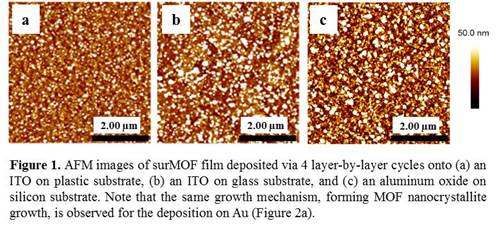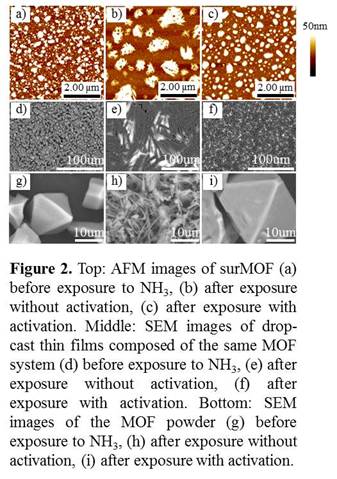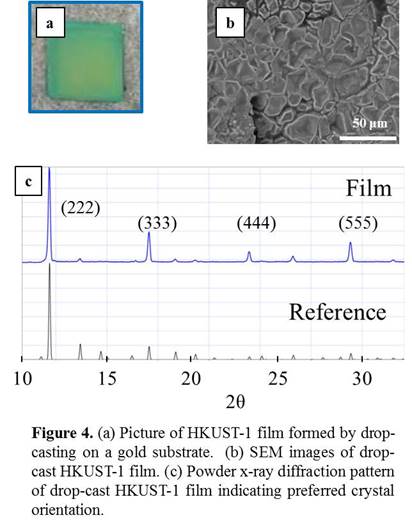Reports: UNI554106-UNI5: Assembly and Characterization of Metal-Organic Coordinated Thin Films with Designed Catalytic Sites
Mary Elizabeth Anderson, PhD, Hope College
Porous metal-organic frameworks (MOFs) can be tailored and tuned both chemically and physically for applications ranging from gas sequestration to drug delivery. Over 20,000 different MOFs have been synthesized to date with new systems reported at a rapid rate. With this large number of systems designed, research must investigate how to integrate them into existing technologies. The approach studied here has been fabrication of primarily surface-anchored MOF (surMOF) films with fundamental studies exploring 1) growth mechanism of thin film formation, 2) effect of gas exposure on film structure and morphology, and 3) ability to tailor film structure using different fabrication techniques or through controlled introduction of dopants within framework.
This report primarily contains results during funding period from September 2015 to August 2016.
During the first year of funding, we were able to determine that i) thin film growth mechanism is Volmer Weber for HKUST-1 during layer-by-layer formation of foundational layers (1-10) and ii) surface morphology and crystal orientation could be tailored based on deposition temperature. These findings were published in Langmuir in 2015. The same growth mechanism, resulting in isolated crystallites, is observed for a variety of substrates (Figure 1).
The effect of gas exposure on surMOF films was investigated by scanning probe microscopy (SPM) to map surface morphology and infrared spectroscopy (IR) to track gas uptake. Findings showed that ammonia gas was uptaken into films that had and had not undergone activation via heating. However, a dramatic morphological change was observed for films that did not undergo activation before exposure. Since our last progress report, we have found that this same phenomenon also occurs for thicker films formed by drop-cast crystallization and for powder samples. The morphology of these materials was characterized by scanning electron microscopy (SEM). Figure 2 shows morphological changes for all three forms of the MOF material. The crystal structure of the film and powder were characterized by x-ray diffraction (XRD). This research is currently being written up in a manuscript for submission in the Journal of Physical Chemistry C.
We have investigated the layer-by-layer growth mechanism of other MOF systems with larger pore sizes and have found a system that seems to grow by a different growth mechanism, Van der Merwe. Film thickness has been found to increase linearly with increasing deposition cycles while SPM shows that roughness stays consistent and the film morphology is conformal with the underlying gold substrate (Figure 3). IR indicates that the molecules are not lying flat on the substrate. At this point, we have not been able to characterize the crystallinity of the film and have not been able to verify the porous nature of the material. Advanced characterization techniques, such as NEXAFS and GIXD, are being pursued to more fully characterize the film and determine if a porous metal-organic framework has been formed or a more densely packed metal-organic multilayer structure. A continuous smooth MOF film on the sub-10nm regime would be an exciting breakthrough in the realm of surMOF research.
Thin films of HKUST-1 MOF have been formed by drop-cast crystallization yielding a film with crystalline preferred orientation (Figure 4). The effect of incorporating other metal (II) ions as dopants into the framework has been investigated using SEM, energy dispersive x-ray spectroscopy (EDS), and XRD. As more dopants are included in the film (up to 40%), initial findings with EDS show that dopant ions are uniformly dispersed throughout film. While there is less preferred orientation found by XRD and smaller grain structures observed via SEM with increasing dopant amounts, the crystal structure remains consistent with that of HKUST-1. UV-Vis has successfully been used to detect the presence of these dopants in the film.
Controlling film morphology via pre- or post- processing methods has been studied. It has been found that depositing a seed layer can determine film roughness and surface coverage. Specifically it was found that these seed layers utilized prior to drop-cast crystallization yielded higher surface coverage of the MOF at lower deposition solution concentrations, enabling thinner and smoother films to be fabricated. A manuscript regarding these deposition methodologies is in preparation for Journal of Colloid and Surface Science.
Three seniors engaged in this research and supported by this PRF funding during Summer 2014 and 2015 graduated in May 2016 and all of these chemistry majors are now pursuing graduate school. Lauren Gentry is participating in the Memphis Teacher Residency program, pursuing a Masters Degree in Urban Education while teaching chemistry at an inner-city high school. Bowser and Ohnsorg are attending Chemistry graduate school at Duke University and University of Minnesota, respectively. Building on her research, Ohnsorg was awarded an NSF Graduate Research Fellowship Honorable Mention and won 2nd place at NDCONNECT (Notre Dame Competition in Nanoscience and Nanoengineering). Both Bowser and Ohnsorg wrote senior theses regarding their research for their ACS-certified BS in Chemistry.
During the summer of 2016, the stipends of two students (Landon Brower and Ashley Trojniak) were supported with PRF funds and the research efforts of a third student (Amanda Napier) aligned with the aims of this proposal. Brower is a rising junior chemistry major involved in this research for his second summer. He is planning to attend dental school. Trojniak is a rising sophomore chemistry major interested in continuing to pursue research opportunities. Napier, a senior chemical engineering major, will graduate in December 2016 and plans to pursue working in industry.
Since August 2015, research students presented 2 talks and 3 posters externally regarding this research. On campus, through departmental and campus-wide events research students presented 3 talks and 9 posters to peers, professors, and members of the community.
Since May 2014, funding from this PRF grant led to 1) a peer-reviewed ACS publication, 2) research findings that helped procure an NSF-RUI research grant, 3) two manuscripts in preparation, 4) 7 students engaged in the research supported, and 5) 11 external and 30 internal student presentations. This PRF and the aforementioned outcomes contributed to a successful tenure and promotion decision for the PI.















